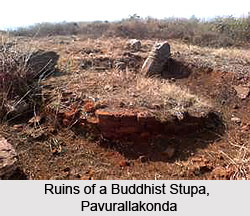 Pavurallakonda Hill, which is popularly referred to Narasimhaswamy konda or Pavurallabodu, Andhra Pradesh is located close to Bheemunipatnam, which is based about 25 km from Vishakhapatnam. It is present at an altitude of 150 metres above mean sea level. Pavurallakonda comprises a ruined hill summit which is known as Buddhist Monastic Complex, which bore testimony to the inhabitation of humans from the 3rd century BC till the 2nd century CE. Pavurallakonda is said to be amongst the most gigantic Buddhist monasteries of the north coastal region of Andhra Pradesh. The philosophy of Hinayana Buddhism used to flourish at this hilly region.
Pavurallakonda Hill, which is popularly referred to Narasimhaswamy konda or Pavurallabodu, Andhra Pradesh is located close to Bheemunipatnam, which is based about 25 km from Vishakhapatnam. It is present at an altitude of 150 metres above mean sea level. Pavurallakonda comprises a ruined hill summit which is known as Buddhist Monastic Complex, which bore testimony to the inhabitation of humans from the 3rd century BC till the 2nd century CE. Pavurallakonda is said to be amongst the most gigantic Buddhist monasteries of the north coastal region of Andhra Pradesh. The philosophy of Hinayana Buddhism used to flourish at this hilly region.
Pavurallakonda implies `The Hill of the Pigeons` since the term `Pavuralu` means pigeons as per the Telugu language and the term `konda` means hill. However, some of the historical accounts also state that this region was termed as Pavurallakonda since it possessed white stone on top of the hillock. But the exact origin of the name of Pavurallakonda is clouded in mystery.
Numerous ancient relics have been unearthed from this historical site, thanks to some excavations conducted here. Circular `Chaityas`, `Viharas`, halls, votive stupas, two Brahmi inscriptions and other archaeological structures have been revealed by these explorations. The State Archaeology Department of Andhra Pradesh have been able to recover beads, polished artefacts and coins. About 16 rock-carved cisterns have been constructed over the hills for the purpose of preserving rainwater. Further archaeological excavations are been carried out at Pavurallakonda. Gosthani River flows across Pavurallakonda. Pavurallankonda existed during the same time as the existence of Buddhist sites of Thotlakonda and Bavikonda, which also were located in the district of Vishakhapatnam. The authorities who have been entrusted the task of carrying out excavations have requested The Indian National Trust for Arts and Cultural Heritage or INTACH for enhanced conservation of the rare Buddhist sites like Pavurallakonda, Bojjannakonda, Thotlakonda and Bavikonda. This can be implemented is these areas are declared as `Heritage Sites` by UNESCO.
This article is a stub. You can enrich by adding more information to it. Send your Write Up to content@indianetzone.com



















